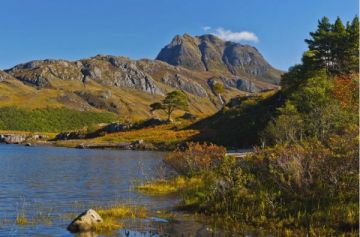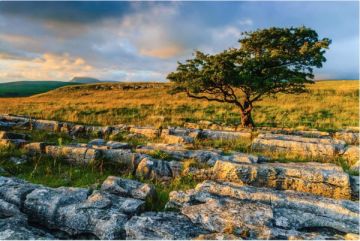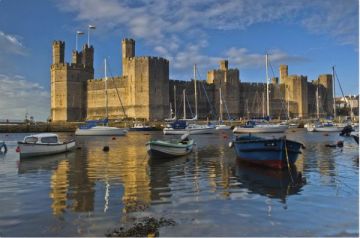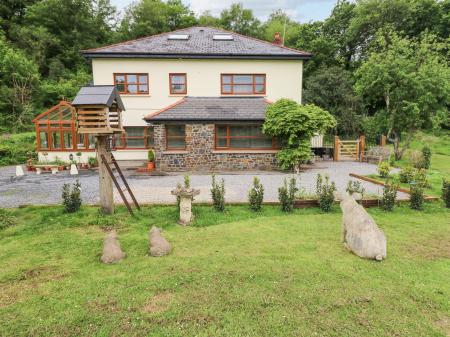<< Back - VIRTUAL TOUR
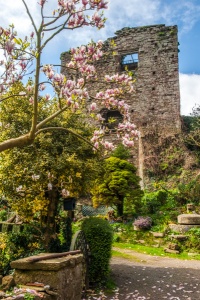
The Wye and Usk rivers meander through green valleys and rolling hillsides, dominating the landscape of this area. Whether touring by car or walking, scenic trails, charming towns and villages and historic sites are around every corner. The Wye Valley Walk is a waymarked walk along the spectacular gorge of the Wye as far as Monmouth in Wales.
This area, on the border between England and Wales, was once fighting ground for Romans and Normans alike. The Welsh clashed with the English Marcher Lords over control of the land resulting in, possibly, more castles per square mile than anywhere else in Britain.
The town of Usk was once a Roman legionary fort until Caerleon overshadowed it in importance. It is considered one of the most significant Roman sites in Wales, and there is much of the Roman past to see here.
Chepstow is a historic walled town where Britain's first stone-built castle is perched on the edge of a bluff above a loop in the River Wye. The town was named Striguil in Norman times, but became known as Chepstow from the old English "ceap stowe" meaning market place. A tariff was collected at the 16th-century town gate on all cattle and goods that passed through.
In later years Chepstow became a busy timber trading and shipbuilding port. The museum has displays on the industries and occupations of the town over the years. There's a scenic walk along the River Wye.

North of Chepstow the wooded Wye Valley reaches from Tintern to Monmouth. Tintern Abbey, in a remote area of the Valley - now designated an Area of Outstanding Natural Beauty - was founded by the Cistercians in 1131, the first Cistercian abbey in Wales. The abbey church, missing its roof and windows is well preserved otherwise (thanks to some help by the Duke of Beaufort in the 18th century), and its architectural splendour is still visible
Nearby Tredegar House, on the outskirts of Newport, a very busy city, is a grand post Civil War house. The rich Morgan family were the owners, but future generations became impoverished, and the house passed into public ownership. Today its grounds are a public park. The interiors, open to viewing, are luxurious evocations of wealth with carvings, wood panelling and gilding
Penhow Castle, a lived-in privately owned castle, covers 800 years of history, reflected in the variety of its rooms.

Tredegar House
Monmouth, an ancient market town, derives its name from the River Monnow. It is actually located on land between both the Wye and the Monnow rivers. The Normans used it as a religious, commercial and military site. The only castle remains are the great gatehouse built in the late 14th century. Henry V was born in the castle. However, there is a fine Renaissance home in the castle grounds. It contains a Regimental Museum with the castle's history.
The town's medieval street plan is still in place, including the uniquely designed 13th-century Monnow Bridge with its fortified gatehouse. At one time there were seven medieval churches in Monmouth. Followers of Lord Nelson will want to visit the Monmouth Museum, which holds a wealth of personal objects linked to the famous admiral.
Grosmont is a charming hillside village with the ruins of one of the "Three Castles" (the others being Skenfrith and White) built by the Normans to control the Herefordshire-Usk Valley routes. Grosmont's name comes from the French gros mont meaning big hill.
The remains of Grosmont Castle sit on the edge of the village on an earthen hill. Originally the ground floor served as a basement, and the main rooms were on the first floor. Later a stone curtain, gatehouse and towers were added. Henry III stayed here in 1233. In the 14th century, the castle was remodelled to suit a noble household. It was a favourite residence of the Earls of Lancaster. 800 Welshmen died here in battle in 1405 during Owain Glyndwr's rebellion
Skenfrith Castle was a timber and earth castle that was levelled and replaced in the early 1200s by stone. The circular keep is the main feature. It stands at the centre of a ward that has round towers on each corner.

The spectacular ruin of Llanthony Priory lies in the Black Mountains on the far eastern edge of the Park. A chapel dedicated to St. David was established here in the 6th century. The chapel ruins were discovered by William de Lacy, a 12th century Norman knight, who decided to renounce the world and build a new hermitage that evolved into the Augustinian priory we see today. Although mostly a ruin, eight surviving early English arches and superb stonework decorations grace the green hills
Abergavenny is full of historic, architectural, cultural and scenic interest. A motte and bailey Norman castle (scant remains), former seat of the lords of Abergavenny, houses a local museum in its 19th century keep. Many of the town's original buildings still exist. St Mary's, formerly a priory church, was restored in the 19th century but still retains its 14-15th century choir stalls. The church has an extensive collection of effigies, considered some of the best in Britain. Three alabaster tombs are located in the Herbert Chapel. The 15th century figure of Jesse is extraordinary.
Raglan Castle's 15th century ruins rise above the Monmouth-Abergavenny road. This castle served for more than defensive purposes. Luxury was an important consideration, and traces of decoration and fine stonework can be found.
